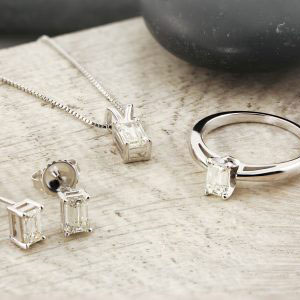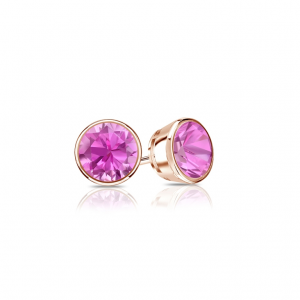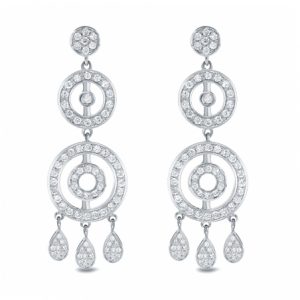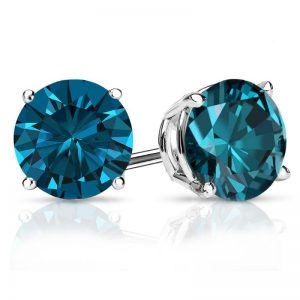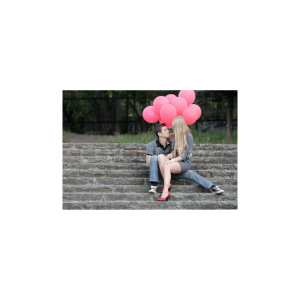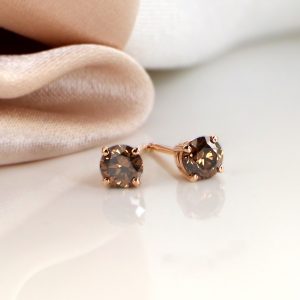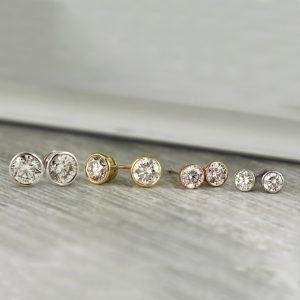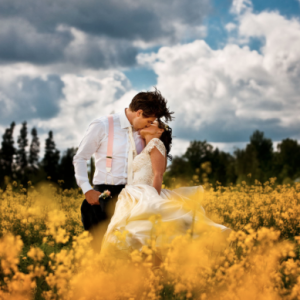
Cushion cut diamonds are a gorgeous, vintage-style diamond shape. If you’re considering buying cushion cut diamond studs, you may be wondering how to pick the right cushion cut diamonds for you. We’re here to help! In this guide to buying cushion cut diamond stud earrings, we’ll teach you everything you need to know about this diamond shape. We’ll cover the definition, history, and cut of this shape. Then, we’ll give some specific recommendations for what you may want to look for when buying cushion cut diamonds and answer some frequently asked questions about the cushion cut. Here are our top tips you should know when buying cushion cut diamonds studs!
1. Understand Cushion Cut Diamonds: Definition
What is a cushion cut diamond? Cushion cut diamonds are a specific diamond shape with a specific cut. They’re shaped like a square with rounded edges, just like a cushion. Cushion cut diamonds feature a modified version of the round brilliant cut diamond’s faceting pattern.
2. Understand Cushion Cut Diamonds: History
Cushion cut diamonds actually evolved from a much older diamond shape: the old mine cut. The old mine cut was a very popular diamond shape in the Georgian and Victorian eras (these span from 1714 to 1901). Back then, the old mine cut was popular for its softened square shape and how it reflected light. This diamond shape beautifully reflected the light that came from the soft candlelight used in Georgian and Victorian homes in the evenings.
The old mine cut fell out of fashion after electricity was invented, as it didn’t reflect artificial light as well as it did candlelight. However, after the brilliant cut was invented in 1919, diamond cutters outfitted the old mine cut’s shape with the brilliant cut, creating the cushion cut diamond. (Note: The brilliant cut is used on many other modern diamond shapes, such as round cut diamonds, oval cut diamonds, pear shaped diamonds, marquise diamonds, and princess cut diamonds.) The cushion diamond has the best of both worlds: the old world beauty of the old mine cut’s shape and the high sparkle of the modern era’s brilliant cut.
3. You Have Cut Options
Some diamond shapes have a standard number of facets. However, within the cushion cut diamond category, there’s a pretty wide range of faceting styles. All cushion cut diamonds feature a modified brilliant cut, a version of the same cut used on round brilliant diamonds. But the number of facets used in this modified cut can vary widely.
A typical cushion cut diamond will have 58 facets. These cushion diamonds have the traditional, chunkier cushion cut look. But you can also find cushion cuts with an extra row of facets. The GIA classifies this type of cushion cut diamond as a “modified cushion cut.” Modified cushion cut diamonds have what’s known as the “crushed ice” look. The higher number of facets used in modified cushion cut diamonds gives them a more intricate look, similar to the look seen in radiant cut diamonds.
4. How to Select a Cushion Cut Diamond: The 4Cs

The Four Cs— cut, color, clarity, and carat— are important to understand when buying any diamond. But what should you look for when buying a cushion cut diamond? Below, we’ve outlined our diamond quality recommendations for this shape.
Diamond Cut and Cushion Cut Diamonds
Diamond cut is the measurement of how well a diamond was cut. Jewelers and gemologists generally recommend that you prioritize diamond cut when buying any diamond shape. This is true whether you’re buying diamonds for diamond earrings or a center diamond for your diamond engagement ring. This is because cut has a big impact on how brilliant (meaning, sparkly) your diamond is. To ensure you get a cushion cut diamond that is highly brilliant, we recommend going with a cut grade of Very Good or Excellent.
Diamond Color and Cushion Cut Diamonds
Diamond color is a measurement of how white a white diamond is. Cushion cut diamonds tend to show their color a bit more than other diamond shapes. For this reason, we recommend going with an H color grade or better for cushion cut diamonds studs. If you’re shopping for a cushion cut diamond for an engagement ring, which will be viewed more closely than diamond earrings, you may want to select a G color diamond or above.
Diamond Clarity and Cushion Cut Diamonds
Diamond clarity is a measurement of how flawed a diamond is. Diamonds can have internal flaws, called inclusions, or external flaws, called blemishes. Cushion cut diamonds have a brilliant cut, which is generally better at hiding flaws than the step cut faceting style. For that reason, we would say you can go a bit lower in clarity for cushion cut diamonds. However, cushion cut diamonds do still have a large open table. So we would recommend going with a clarity
grade of SI1 or better. Cushion cut diamonds with a clarity grade of SI2 or below tend to be less likely to be eye clean.
Diamond Carat and Cushion Cut Diamonds
Diamond carat is weight measurement that can give you a good idea of a diamond’s size. Choosing your diamond’s carat is usually a matter of personal preference and/or budget considerations. If you want the largest cushion cut diamond that will fit into your budget, we would recommend first deciding on what you want for the quality of your cushion cut diamond. Then, select the highest carat weight diamond you can find with those qualities.
Note: When you shop for cushion cut diamond stud earrings, you’ll be buying a pair of cushion cut diamonds. A pair of cushion cut diamonds will usually have their carat weight listed followed by “ctw.” Ctw stands for carat total weight. So know that the listed carat weight for diamond studs is the combined total weight of both diamonds. For example, if a pair of diamond studs has a ctw of 1, each diamond will be 0.5 carats.
5. How to Select a Cushion Cut Diamond: Ratio, Depth, Polish, and Symmetry

Beyond just thinking about the 4Cs, you’ll want to consider a cushion cut diamond’s ratio, depth percentage, polish, and symmetry.
Cushion Cut Diamond Ratio
A cushion cut diamond’s ratio will tell you how square a cushion cut diamond is. Traditionally, cushion cut diamonds are square in shape, with a 1:1 (1.00) length-to-width ratio. However, you’ll also find cushion cut diamonds with larger length-to-width ratios. These cushion cut diamonds will look more rectangular. Choosing ratio is a matter of personal preference. Most people prefer a slightly rectangular cushion cut diamond that has a length-to-width ratio of 1.10 to 1.20. However, if you want a more square cushion cut diamond, look for a ratio between 1 and 1.09. If you want a more elongated, rectangular cushion cut diamond, look for a ratio between 1.15 to 1.5.
Cushion Cut Diamond Depth Percentage
While ratio is more a matter of style, depth percentage can affect the quality and sparkle of your cushion cut diamond. For the most brilliant cushion cut diamond, look for a depth percentage that’s under 70% and a table percentage that’s under 70%.
Cushion Cut Diamond Polish and Symmetry
Polish and symmetry can both affect the quality of your cushion cut diamond. For the best quality and sparkle, look for cushion cut diamonds with polish and symmetry ratings of Excellent.
FAQ About Cushion Cut Diamonds

Q: What precious metal is best for cushion cut diamond jewelry?
A: All precious metals look beautiful with cushion cut diamonds. However, if you select a colorless cushion cut diamond (with D, E, or F color) for your diamond jewelry, you may want to select a white precious metal, like platinum or white gold. This will ensure your diamond looks as white as possible. If you go lower in diamond color, you may be happier with a warmer precious metal like yellow gold or rose gold. Rose gold and yellow gold will look more harmonious with a faintly yellow diamond.
Q: What setting should I choose for cushion cut diamonds?
A: The setting you should choose will depend on the style you want for your diamond jewelry. Prong settings (like three prong, four prong, and six prong settings) have a classic look and maximize brilliance. Then, bezel settings have a modern look, especially in solitaire designs, while halo settings add glamour and impact.
Q: How much do cushion cut diamonds cost?
A: The price of a cushion cut diamond will vary depending on its carat weight and quality. To give you an example, a 2 carat diamond that is cushion cut can cost anywhere from $8,000 to $29,000.
Q: Are cushion cut diamonds a good value? Are they the best value?
A: Cushion cut diamonds are one of the more affordable diamond shapes. The most expensive diamond shape is easily the round brilliant. All fancy shaped diamonds are less expensive than round diamonds, including cushion cut diamonds. Other fancy shaped diamonds that are more affordable than round diamonds include princess cut, emerald cut, asscher cut, marquise cut, radiant cut, oval shaped, pear shaped, and heart shaped diamonds. Among all the fancy shaped diamonds, cushion cut, radiant cut, and emerald cut diamonds tend to be the most affordable.
Q: Why are so many gemstones and colored diamonds cushion cut?
A: The cushion cut tends to show color more than other shapes. This can be a slight disadvantage for a white diamond, as it can make a diamond look slightly more yellow than its color grade would suggest. That’s why we recommend going with an H grade cushion cut diamond or higher for diamond studs. However, it’s a big advantage for gemstones and colored diamonds. The cushion shape accentuates color, which is ideal for colorful gemstones and diamonds.
Q: Are cushion cut diamonds popular?
A: Cushion cut diamonds are still a more rarely chosen shape for diamond jewelry, such as diamond stud earrings and diamond rings. However, they have been rising in popularity in recent years.



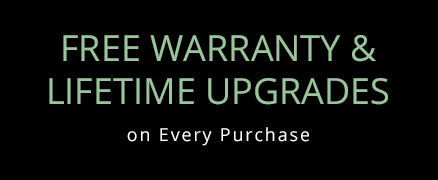
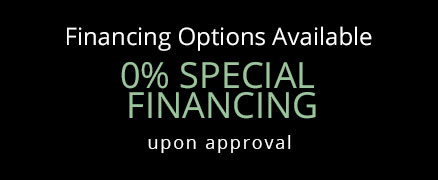


 1-855-969-7883
1-855-969-7883 info@diamondstuds.com
info@diamondstuds.com



